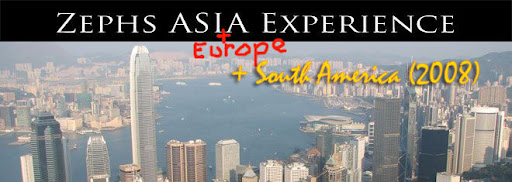It's dark when I wake up and go to work.
It's dark when I finish work and go home.
South America? It didn't happen.
What happened? After Ecuador I went to Peru to meet up with Karin, we traveled to Bolivia (had some fun and saw a lot of salt), went on to Argentina (saw some waterfall and did some tango in Buenos Aires), went on to Brazil (did some beach and island stuff and saw some Rio) and that was it. Flied home, freezed my ass of getting out of the plane, and took the train back to my beautiful city of Apeldoorn! Had some drinks and sleep and kickstarted my career when the weekend was over. That's it!
Well I wrote something when I was waiting at the airport in SP, and you can read it below between the photo's.
For the sake of writing a conclusion I will share a few thoughts with you concerning my travels:
- Try to like rice before you go to South America
- People from the US are the most screwed up people that I have met (in general, if you are reading this and you are aware of my blog you are most probably part of the non-screwed up part.)
- Speaking Spanish and being able to dance drastically improves your luck with the locals
- Try to like bananas if you head North and expect it to be part of your food. Always.
- Couchsurfing is a fantastic way if you want to meet local people
- It's also a fantastic way to meet total nut heads
- Colombia is the best country of South America, except that they put cheese in their tea and hot chocolate milk
- Rio has it all: beach, parties, nature, criminals and cops that want you to undress yourselves
- I'll definitely return someday
- Which is a standard expression for travelers who afterward start their career, get a family, and never return.
After leaving Ecuador I headed east towards the south of Peru to meet up with Karin and travel with her for a while through Bolivia. I took buses for like 3 days in a row, stopping only in Cuenca (south of Ecuador) and Puira (north of Peru) to spend the daytime and continue the body breaking bus travels towards Arequipa. In Lima I was easily convinced by some people to stay for two days instead of 8 hours. It was a great break, and I actually liked the city (usually people hate it). But there's a story to it! When I was young, my parents gave me a train and tracks that I could build throughout the room, keeping me from the streets at the age of 4. The brand of this train was "Lima". When someone told me that was actually a city far far away, the city of Lima was planted in my brain as a magical city where I would probably never go. Anyway, I did go, it was not magical, but still good. Didn't see any trains though.
Ok so after some 3000km from Quito I finally found Karin hidden in the dust and heat of Arequipa. I washed my clothes which dried in like 10 seconds, was showed around Arequipa in a few hours (thanks Karin, I like speed tourism now and then) and we set off to Bolivia. To cut things short, we spent some time walking and doing nothing at Isla del Sol, visited La Paz for a few days where we became short term friends of some Argentinians and Brazilians in an all Irish hostel (how did we get there again?) and then traveled, with the two, to the salt deserts. It's this white stuff you see i the pictures.
After the salt adventure our roads split, Karin discovering Chile, me discovering Argentina. First stop was Salta, where I met with Ramiro and his nephew. They showed me around the city, which reminds me most of Apeldoorn. It even had a C&A in the main street! Ramiro teached me "peddles", until then an unknown sport to me, but it seems like a fusion of tennis and squash. Ramiro plays it regularly, so in order not to hurt his feelings, I have let him win with 4-6, 6-4, 6-7.
Ok, then I went to Cordoba, Argentina's 2nd largest city. Was a bit bored there, but did see a little cute small village near the city. Wait, that was actually boring too. Well what did surprise me were the just made friends that were inhaling cocaine like it was oxygen, telling me it was not addictive at all while their hands were shaking, and at the same time asking me if I really wouldn't want to try as well.
Buenos Aires! To cut it short: beautiful city, and of all I liked tango the most of South America's dances. Because I understood.
Iguazu falls! At the border of Argentina and Brazil.
Then, just as the Spanish language was fluidly coming from my tongue after three months of practice, I entered Brazil. They (the Portuguese) say Portuguese is pretty much like Spanish, but it's not. Not really a problem: Ilha Grande and Rio de Janeiro were still a lot of fun. Especially Rio where people just go out every night and come back just in time to catch the bus to work. It really surprises me that Brazil has the best economy of South America.
Ah and I saw Sao Paulo FC win the Brasilian league, in Rio!
Last two days I spent with Maria, who I met in Colombia three months ago, in Sao Paulo. Finished off in style with a great Portuguese concert last night! Now, having a cold (how does my body know I'm going to Holland?) and a hangover, I'm waiting to catch my plane back home, contemplating life over there...

